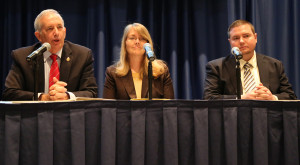Sen. Dean Mortimer told a roomful of educators on Thursday morning: “it’s time to change.”
Mortimer was a panelist at the K-12 Blended Learning Summit held at Boise State University. The four-hour event was focused on “what’s working and how to move forward” with new learning models, especially blended learning and technology use in the classroom. About 100 people – mostly educators – attended the free event sponsored by Bluum, Boise State University and Northwest Nazarene University.

Mortimer spent most of the morning listening to speakers discuss “new learning models” and “blended learning efforts” and then he shared his takeaways with the audience:
“We as a state need a student-centered learning system and we are well on our way,” said Mortimer, chair of the Senate Education Committee. “We have to empower our students and our parents and explore new learning models.”
Mortimer, Rep. Wendy Horman and Will Goodman, the State Department of Education’s chief technology officer until June 30, shared a panel discussion on how policymakers can support educators who embrace blended learning models and innovative teaching practices. The panel built on earlier conversation and discussed if there are areas where state law and rules may be more supportive of efforts to do more with technology, blended learning and innovation.
Horman shared a personal experience where she took her son out of the traditional learning environment and put him into an online learning class.
“He had a better experience and a more personal connection with his online teacher,” she said. “We need to support blended and online learning opportunities.”
Goodman, who earlier this week resigned from the State Department, warned the audience that there is still a negative connotation around online learning in Idaho.
“Teachers see this as a replacement and there is a fear of losing control,” he said. “Plus, more modern teaching methods don’t look like teaching and these things need to be addressed.”
Mortimer said he’s willing to support funding for innovation and pilot programs and give districts more flexibility to try new things.
Horman would like to see Idahoans analyze what’s happening in other states and countries.
“Finland has a terrific career-ladder model,” she said. “Are there pieces we can apply in Idaho? We need to duplicate, replicate and steal the best be can.”
Horman is now an “empty-nester” since her last of five children graduated from high school. She said she plans to register as a substitute teacher so she can stay connected to education. She is a former trustee with the Bonneville School District in Idaho Falls.
Both Horman and Mortimer complained about the state’s funding model.
“It needs to be changed,” Mortimer said. “We have to be able to compensate differently to provide for innovation and things like mastery-base or blended learning.”
Horman said: “I wonder about the necessity of the complexity and I wonder what I can do to modernize it.”
One audience member asked about increasing funding for IT directors, since technology is becoming an increasingly important tool in the classroom.
“I’m looking at how we can accommodate the more expensive classified positions,” Horman said and talked of a “super classified” pay scale.
Mortimer agreed: “I think we’ll see headway on that.”
Note: Idaho Education News is sponsored by the J.A. and Kathryn Albertson Family Foundation and Boise State University. Bluum is also funded by the J.A. and Kathryn Albertson Family Foundation.
